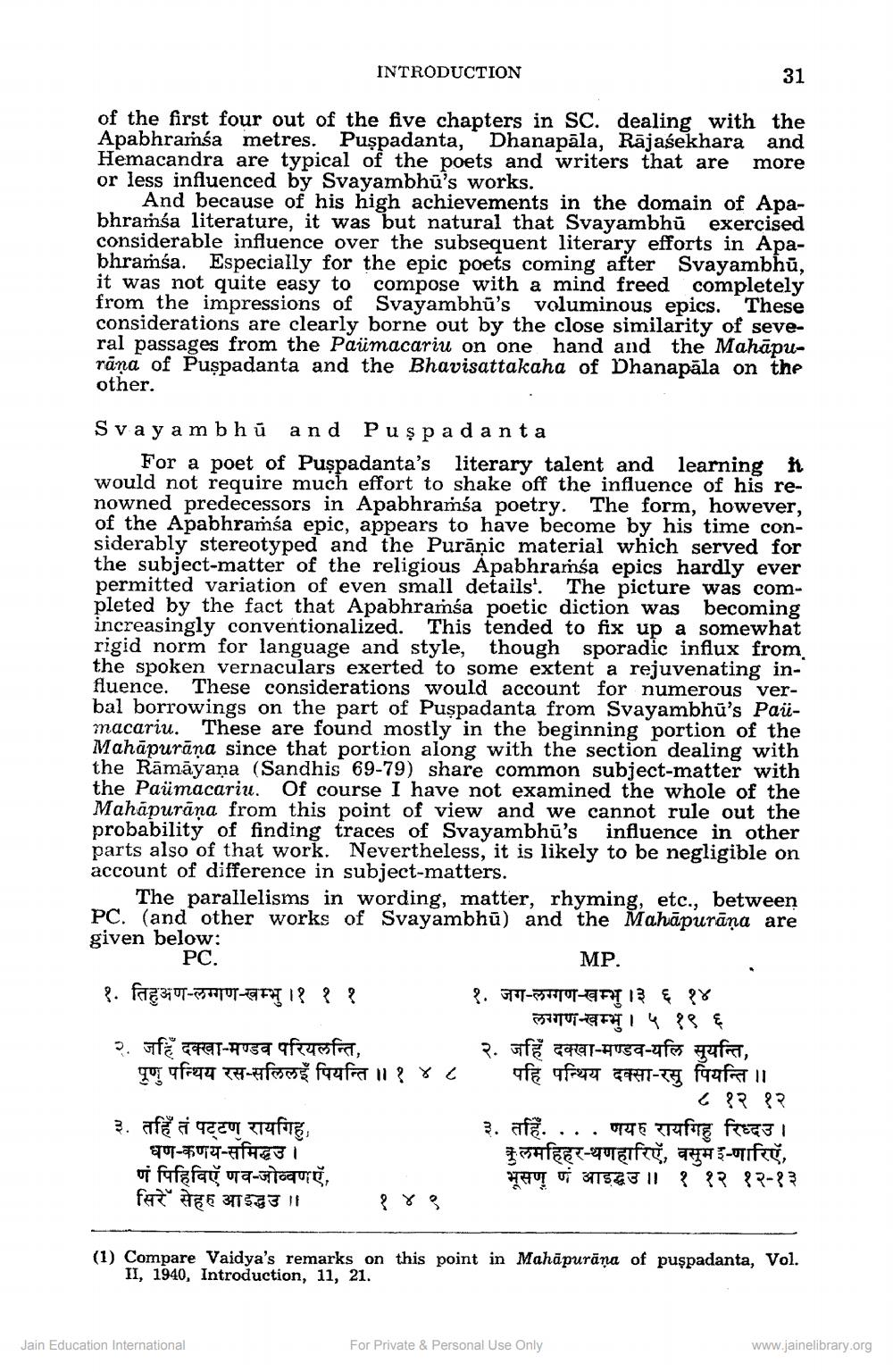________________
INTRODUCTION
31
of the first four out of the five chapters in SC. dealing with the Apabhrarnsa metres. Puşpadanta, " Dhanapāla, Rājasekhara and Hemacandra are typical of the poets and writers that are more or less influenced by Svayambhu's works.
And because of his high achievements in the domain of Apabhramśa literature, it was but natural that Svayambhū exercised considerable influence over the subsequent literary efforts in Apabhrarsa. Especially for the epic poets coming after Svayambhū, it was not quite easy to compose with a mind freed completely from the impressions of Svayambhu's voluminous epics. These considerations are clearly borne out by the close similarity of several passages from the Paümacariu on one hand and the Mahāpurāna of Puşpadanta and the Bhavisattakaha of Dhanapāla on the other.
Sva y am bhū and Puşpadanta
For a poet of Puspadanta's literary talent and learning h would not require much effort to shake off the influence of his renowned predecessors in Apabhramsa poetry. The form, however, of the Apabhramsa epic, appears to have become by his time considerably stereotyped and the Purānic material which served for the subject-matter of the religious Apabhramśa epics hardly ever permitted variation of even small details'. The picture was completed by the fact that Apabhramsa poetic diction was becoming increasingly conventionalized. This tended to fix up a somewhat rigid norm for language and style, though sporadic influx from the spoken vernaculars exerted to some extent a rejuvenating influence. These considerations would account for numerous verbal borrowings on the part of Puspadanta from Svayambhu's Paümacariu. These are found mostly in the beginning portion of the Mahāpurāna since that portion along with the section dealing with the Rāmāyana (Sandhis 69-79) share common subject-matter with the Paümacariu. Of course I have not examined the whole of the Mahápurāna from this point of view and we cannot rule out the probability of finding traces of Svayambhu's influence in other parts also of that work. Nevertheless, it is likely to be negligible on account of difference in subject-matters.
The parallelisms in wording, matter, rhyming, etc., between PC. (and other works of Svayambhū) and the Mahapurāna are given below: PC.
MP. १. तिहुअण-लग्गण-खम्भु ।१ १ १
१. जग-लग्गण-खम्भु ।३ ६ १४
लग्गण-खम्भु। ५ १९ ६ २. जहिँ दक्खा-मण्डव परियलन्ति,
२. जहिँ दक्खा-मण्डव-यलि सुयन्ति, पूणु पन्थिय रस-सलिलइँ पियन्ति ॥ १ ४ ८ पहि पन्थिय दक्सा-रसु पियन्ति ।
८ १२ १२ ३. तहिँ तं पट्टण रायगिहु,
3. af. ... 045 refire FRECJI 90T-FUTU-AHEJI
कुलमहिहर-थणहारिऍ, वसुम इ-णारिएँ, णं पिहिविएँ णव-जोव्वणएँ,
भूसणु णं आइद्धउ ॥ १ १२ १२-१३ सिरे सेहरु आइद्धउ ।। १४ ९
1
(1) Compare Vaidya's remarks on this point in Mahāpurāna of puşpadanta, Vol.
II, 1940, Introduction, 11, 21.
Jain Education International
For Private & Personal Use Only
www.jainelibrary.org




